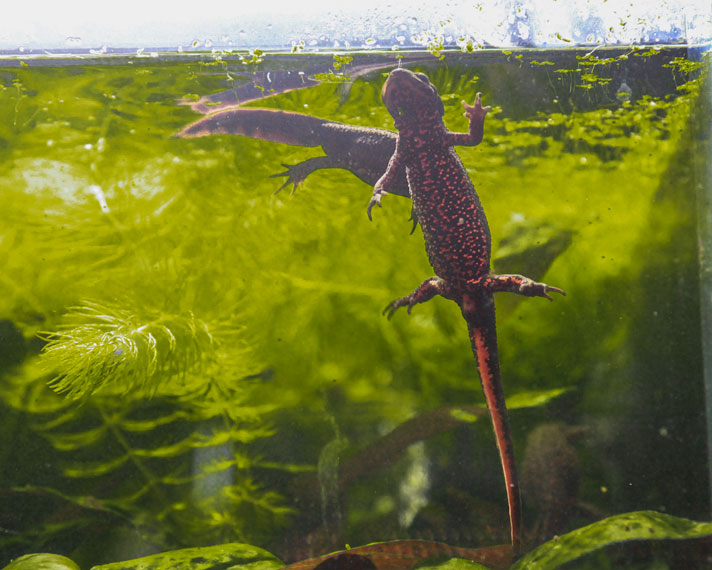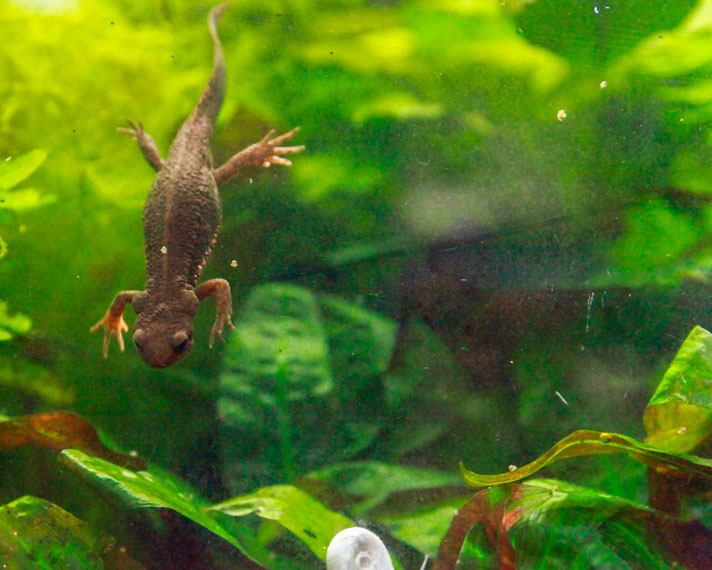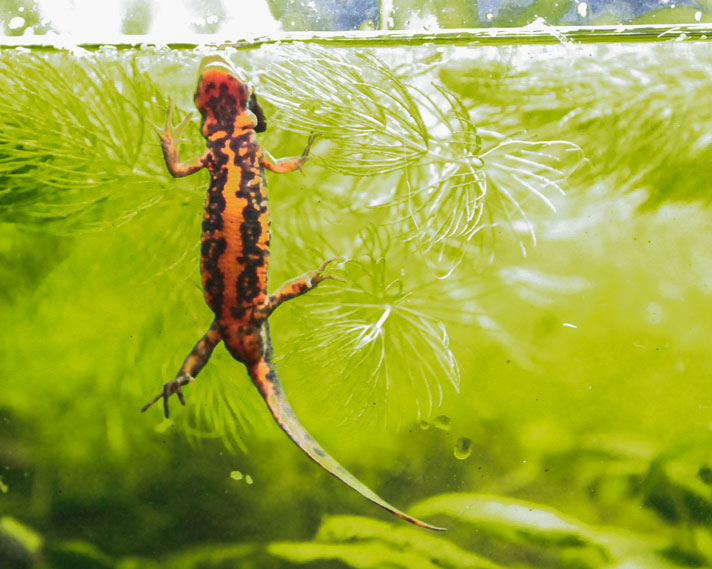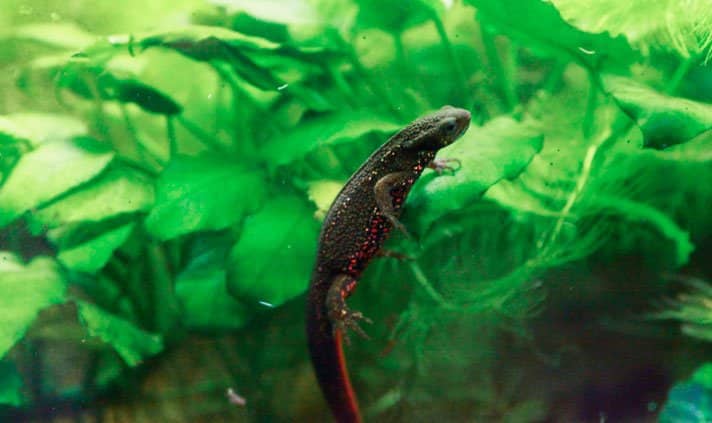With proper care, the Japanese fire-bellied newt can live more than 25 years.
Cynops pyrrhogaster—or Japanese fire-bellied newts, as they are popularly known by—were, for decades, the most commonly imported and kept nonnative salamander in the US pet trade. Prior to the early 1990s, a common sight in any given local aquarium store was the one amphibian tank. This often consisted of an aquarium half-full of water with a few rocks protruding from the surface. Inside was a marvelous world to the uninformed. Japanese fire-bellied newts swam alongside eastern newts, Notophthalmus species, fire-bellied toads, Bombina orientalis, with the occasional Taricha species thrown in for good measure. In addition, there were often one or two species of fiddler crabs to round out the mix. Today, such a combination would make the dedicated hobbyist cringe.

Foster REves
Cynops pyrrhogaster is hard to find but not impossible. There are breeders out there.
By the late 1990s, importation of Cynops pyrroghaster had decreased significantly, and even prior to the US newt and salamander ban in 2016, it was rare to see them in stores. The smaller Chinese fire-bellied newt, Cynops orientalis, was being imported in huge numbers and had, until 2016, become the most frequently imported newt species at that time.
Newt and Salamander Ban
Effective Jan. 28, 2016, the United States Fish and Wildlife Service issued a ban on the importation and interstate transport of 201 newt and salamander species, including all species of Cynops. The rationale behind this decision was to prevent the introduction and spread of the deadly Bsal fungus, Batrachochytrium salamandrivoranus, to US native amphibian populations. Initially, the backlash among salamander hobbyists was severe. This new law effectively killed much of the trade as it was practiced at the time. A year later, the law was amended to allow interstate transport of captive-bred species. Prior to the ban, acquiring Cynops pyrrhogaster was more difficult to begin with. Since the ban, one must diligently search for breeders who will offer their offspring from time to time.
Japanese Fire-Bellied Newt Background
The genus Cynops contains nine species of old world salamanders that are found throughout China and Japan. In addition to C. pyrrhogaster, C. cyanurus and C. orientalis, other species kept by serious US hobbyists include C. ensicauda ensicauda and C. ensicauda popei. The latter two species are even more difficult to locate now than C. pyrrhogaster.
Japanese Fire-Bellied Newt Distribution
Cynops pyrrhogaster is found throughout Japan. There are five geographical forms, or races, recognized based on belly coloration and pattern as well as other morphological characteristics. These include Sasayamae, Astsumi, Hiroshima, Tohoku and Kanto.
Japanese Fire-Bellied Newt Habitat
Japanese fire-bellied newts are found in a variety of aquatic and semi-aquatic habitats in the wild. Rice paddies, roadside ditches, ponds, puddles and slow-moving streams are just a few of the locations they can be found. Turbulent water is avoided.
Japanese Fire-Bellied Newt Description
C. pyrrhogaster can be considered a medium-sized newt. Males average 3.5 to 4 inches (8 to 10 cm) and females 4 to 4.7 inches (10 to 12 cm). During the breeding season, males will also develop swollen cloaca and broadened tails. Dorsal coloration is a uniform brown. Breeding males often develop a bluish coloration bilaterally on the tail. The ventral surface, or underbelly, as the name suggests, is the defining characteristic of this species. Depending on the race, base color is red, orange or some shade in between. This base color is interspersed to varying degrees with brown, black, or white spots and speckles, often forming intricate patterns.
Japanese Fire-Bellied Newt Husbandry
Overall, Japanese fire-bellied newts are very easy to keep in captivity, as long as good water quality and appropriate temperatures are maintained.
Japanese Fire-Bellied Newt Enclosure Size
Although not huge by caudate standards, Japanese fire-bellied newts are active animals. Generally slow moving, C. pyrrhogaster will actively explore its enclosure. The author recommends a tank size of no less than 20 gallons (75.7 liters) for a pair or two. More space should be provided if additional animals are in the group. The author uses an aquarium size of 36 by 18 by 25 inches (91.4 by 45.7 by 63.5 cm) for a group of five adults.
Japanese Fire-Bellied Newt Enclosure Type
The modern herpetocultural industry now offers a greater variety of commercial vivariums today than ever before. Designs vary, but most models feature a bottom area that is capable of holding water of various depths and front opening doors.
Standard fish aquariums are also suitable and have long been the preferred method of housing aquatic salamanders. Advantages of aquarium use are that the entire structure is designed to hold water, and water depths can be adjusted to a greater degree than most commercial vivariums.

foster reves
The modern herpetocultural industry now offers a greater variety of commercial vivariums today than ever before.
The main disadvantage to using aquariums is that a tight-fitting screen cover will need to be utilized. Salamanders can be amazing escape artists, capable of squeezing through small openings and unsecured spaces. Regardless of which type of enclosure is used, longer models are preferred to excessively tall ones. This allows for greater usable surface area.
Japanese Fire-Bellied Newt Water Depth
Although C. pyrrhogaster will spend much of the time on land in nature, they can be kept aquatically year-round in captivity as long as a terrestrial area is provided. Depending on the size of the enclosure, a water depth of at least 1.5 times the length of the largest animal is sufficient. In larger enclosures, greater depths are fine.
Japanese Fire-Bellied Newt Temperature
Providing a cool enough temperature is one of the greatest obstacles that prevents many caudate species from otherwise thriving in captivity. Many will survive well if not kept over 70°F (21.1°C), however they require sharp drops during the winter to stimulate breeding. Japanese fire-bellied newts are one of a select group of species that can be kept and bred with a minimal winter temperature drop. In addition, slightly higher temperatures are tolerated in the summer.
Temperatures in the 60s°F during the winter will often do the trick. Summertime temperatures should not be any higher than 73°F (22.7° C). Temperatures over 75°F (23.8° C) and above will not be tolerated long and will soon become lethal. Keeping enclosures in a basement or air-conditioned room are the easiest methods to maintain proper temperature. If maintaining the desired temperature presents a problem, then this factor must be heavily weighed-in before ever acquiring any newts.
Japanese Fire-Bellied Newt Lighting
Being nocturnal in nature, C. pyrrhogaster do not require special lighting in captivity. If live plants are being used, then an appropriate light source will be necessary. There are a number of lighting products specifically designed for aquarium and terrarium use on the market.
Ideal Japanese Fire-Bellied Newt Filtration
There are many types of filters available in today’s aquarium market. These can range from simple, air-driven sponge filters to outside canister filters to systems that are self-contained in the tank hood. There are also a number of models available that are specifically designed for low water levels. Power filters that hang on the back of the tank should not be used because it is virtually impossible to secure the outflow area at the top of the tank in order to prevent escape. If other power-driven models are used, such as submersibles, it is important to be able to control the output flow rate. Turbulence in the aquarium must be minimal since fire-bellied newts are poor swimmers in fast flowing water. The author prefers sponge filters driven by an outside air pump. The airline tubing connection can easily be threaded through the mesh of a screen cover without creating an escape route for the newts. Sponge filters provide excellent biological filtration.
Regardless of the type of filter used, regular partial water changes are essential in order to maintain good water quality. The author changes 25 percent of the water in all aquaria once a week.

foster reves
Captive adult C. pyrrhogaster are very easy to feed.
Japanese Fire-Bellied Newt Terrestrial Platforms
Despite being able to be kept in water year-round, C. pyrrhogaster still require an area in which they can climb out of the water when desired. These platforms can either be simple or elaborate, depending on the wishes of the keeper and overall enclosure design. If aesthetics are not a concern, then sections of clean, chemical-free Styrofoam provide a simple and effective land area. If a more natural looking enclosure is desired, perhaps with substrate, driftwood and live plants, then sections of cork bark work well. Cork bark is lightweight, relatively inexpensive and will float for years before becoming waterlogged. The construction of such vivaria are slightly more complicated, however, and is beyond the scope of this article.
Japanese Fire-Bellied Newt Substrate
The decision of whether or not to add substrate to the aquatic salamander tank is one that has been debated on internet forums for years. If substrate is desired, then either sand or fine grade aquarium gravel work well. Larger grade aquarium gravel that can still fit into the newts’ mouths creates the risk of accidental ingestion. Since salamanders swallow food whole through a buccal pump mechanism, it is often too late for regurgitation after ingestion. Gravel logged in the digestive tract is nearly always fatal to the salamander.
Plants
If an appropriate light source is utilized, there are a number of aquarium plants that do well in the cooler environment of the salamander tank. Java moss (Vesicularia dubyana), java fern (Ceratophyllum demersum) hornwort and various Anubias and Riccia species have all thrived in the author’s tanks over the years, and all require regular pruning in order to prevent congestion. Japanese sweetflag (Acorus gramineus) and other emergent species are also a possibility, if space allows. There are most certainly many other species of aquatic vegetation that have the potential to do well in the C. pyrrhoghaster tank. This is an area of exploration that is only limited by an individual’s time and resources. In a more spartan setup, plastic plants designed for aquarium use can also be utilized. There are a number of realistic looking models on the market now.
Hard Décor
Sections of driftwood, either real or artificial, can add depth and surface area to the fire belly newt tank. Other types of natural wood are also available for aquarium use as well. It is important that any natural wood used is treated for aquarium use beforehand, so it is best to buy from reputable dealers and avoid collecting from the wild. Other types of décor, such as artificial stones and ornaments designed specifically for the aquarium can also be used. Actual rocks should be avoided as considerable weight will be added to the tank, and it puts the newts at risk of being crushed if not secured.
Japanese Fire-Bellied Newt Feeding and Frequency
Captive adult C. pyrrhogaster are very easy to feed. A variety of live and prepared foods are accepted. Live foods such as chopped earthworms (Lumbricina sp), blackworms (Lumbriculus variegatus), whiteworms (Enchytraeus buchholzi), along with most commercially available feeder insects, are eagerly accepted. Mealworm species (Tenibrio) should be avoided, in general, because the chitinous exoskeleton can be difficult to digest. Soft, freshly molted larvae, pupae and beetles, however, are an exception and can add variety to the diet. Frozen bloodworms (Glycera and Chironomidae), brine shrimp (Artemia) and beefheart are relished. There are also a number of commercially available dry foods developed specifically for newts and salamanders. With such a wide array of food items to choose from, it is important to vary the diet on a regular basis. The author feeds his adult newts three times a week. It is important not to offer more food than will be consumed in a 10 minute or so time period. Uneaten food will only serve to degrade water quality and should be siphoned out.
Japanese Fire-Bellied Newt Reproduction
In nature, C. pyrrhogaster breed in the spring up to early June, with April being the peak of the season. After courtship, several hundred eggs are laid, individually wrapped in aquatic plant leaves. Larvae hatch after approximately 20 days. Larvae are best reared separately for maximum yield. Live food in the form of newly hatched brine shrimp, Artemia, Daphnia and infusoria should be offered frequently each day. Metamorphosis occurs after 3 to 4 months, at which point the newt will enter the terrestrial stage. The young are approximately 1.5 to 1.7 inches (40-45 mm ) long at this point. Whiteworms (E. buchholzi), flightless fruitflies, (Drosophila sp.) and other small, terrestrial live prey items must be offered at this point. Feeding frequency should be daily at first and can be gradually decreased as the young animals grow. Setups for the terrestrial phase can be rather simple and sterile, with a damp paper towel substrate, shallow water dish and cover in the form of sections of cork bark, dead leaves or small broken shards of clay pots. This method of rearing makes it easier to monitor the food intake and overall health of individual animals. Care must be taken to change the paper towel once it becomes soiled, which can happen quickly if not monitored regularly.

foster reves
Japanese fire-bellied newts are long-lived animals. With proper care, the average lifespan is around 25 years.
The other major method to raise the terrestrial phase is to provide a container with bioactive substrate, dead leaves and small sections of bark or clay shards for cover. The substrate must be kept moist but not saturated, using distilled water. The main disadvantage of this method is that it can be more difficult to monitor the health of individual animals, and care must be taken to avoid mold and potential CO2 buildup. Otherwise, the salamanders will have a more efficient moisture gradient to choose from. In addition, the substrate can be seeded with small isopod and springtail species, which will not only aide in the cleanup of decaying organic matter but also serve as a supplemental food source for the growing pyrrhogaster. Normally, the terrestrial stage can last up to three years before the young adults return to the water to breed. In captivity, some keepers report being able to gradually reintroduce the eft back to water after a period of six months or so. This method involves placing the salamander in a container with shallow water filled with floating plants in order to prevent drowning. If the newt does not feed once moved to this setup, however, it must immediately be placed back in the terrestrial enclosure.
Japanese Fire-Bellied Newt Longevity
Japanese fire-bellied newts are long-lived animals. With proper care, the average lifespan is around 25 years. There are records documenting individuals surviving up to 45 years as well.
Notes on Mixing Species
Despite the classic aquarium store presentation, Japanese fire-bellied newts should not be mixed with other amphibians. All amphibians secrete potentially noxious, if not toxic, chemical from their skin. In the relative tight confines of the home vivarium, there is little escape from the presence of other species.
The overwhelming majority of tropical freshwater fish species are not candidates for mixing based on temperature requirements alone. Goldfish and koi require cool water as well, however, both grow too large and generate too much waste to make suitable tankmates. The author has had success keeping freshwater shrimp species, such as Neocardidina and Cardina with Cynops. The shrimp are generally too fast to become a food source and add an extra dimension to the aquarium.
Conclusion
Once common and often ignored, now rare and coveted, Japanese fire-bellied newts are a joy to keep. Their beautiful underbellies and active nature in captivity make them ideal subjects for the semi-aquatic vivarium, and with proper care, the keeper will be provided with years of personal enrichment.
Foster Reves is a herpetoculturist, martial artist and registered nurse who has bred several other herps over the years, including Goniurosaurus, Abronia graminea, Lepidophyma flavimamulatum, and C. ensicauda ensicauda.



